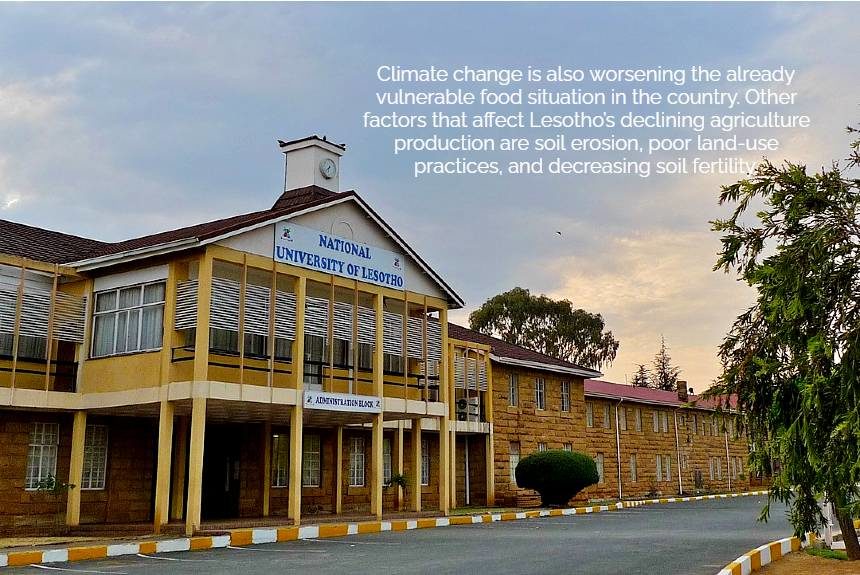Is climate change a driver of food scarcity in South Africa? And if so, to what extent? Food security is becoming a serious concern, especially in poor and developing countries.
Data from the UN Food and Agriculture Organisation (UNFAO) shows that by 2019 two billion people will experience moderate to severe food insecurity. UNFAO’s has four interconnected pillars to measure food security:
- food availability, which is linked to the amounts of food production,
- access to food or whether people can afford to buy food,
- food use or how food is prepared and consumed, and lastly,
- food stability in terms of food supply and consumption.
An article from the Conversation explains the relationship between climate-change-induced droughts and the 2007 food crisis in Lesotho. The article mentions that droughts can negatively impact these four pillars, creating food insecurity or scarcity in the area.
When scientists examined the relationship between climate change-induced drought and food production in Lesotho, they find out that climate change is a significant driver of the country’s food crises in 2007.
The country’s primary product is Maize, but it only produces 30% of its demand importing the rest from its neighbour country, South Africa.
When a severe drought hit in 2007, both countries suffered crop failure. Maize export to Lesotho dropped sharply, which caused its price to double. In the end, Lesotho’s government has had to ask for emergency food assistance for 20% of its population.
To determine the effects of climate change on food production, scientists came up with two scenarios: the factual and counterfactual worlds.
- The first one – the factual world is a warming world and the one we live in today. Scientist finds that drought will increase five times and double the chances that droughts will impact both countries.
- In contrast, the counterfactual world – one without climate change-finds that food shortage is much less likely to occur, and there are even scenarios where food shortage could be prevented entirely.
Climate change adverse effects on Lesotho’s farming households
Researchers also find that climate change decreased the self-sufficiency of farming households in Lesotho by half and decreased their household purchasing power by 37%.
Climate change is also worsening the already vulnerable food situation in the country. Other factors that affect Lesotho’s declining agriculture production are soil erosion, poor land-use practices, and decreasing soil fertility.
United States AIM for Climate
The US rejoining the Paris Agreement is a significant boost for the international climate accord composed of 175 countries uniting against climate change.
On 23 April 2021, the US announced its latest climate action initiative in partnership with the United Arab Emirates: the Agriculture Innovation Mission for Climate (AIM for Climate).
According to the US Department of State:
“The goal of AIM for Climate, which will be advanced at the U.N. Food Systems Summit in September 2021 and launched at COP26 in November 2021, is to increase and accelerate global innovation research and development (R&D) on agriculture and food systems in support of climate action.”
John Kerry, U.S. Presidential Envoy for Climate, calls this program “pioneering”, adding that “we all stand to benefit by sharing best practices and raising innovation ambition when it comes to climate-smart agriculture”.
This initiative will mobilise greater investments in agriculture research and development and innovation, specifically in new ways to sustainably increase agricultural activity, improve livelihoods, conserve nature and biodiversity, adapt and build resilience to climate change while reducing GHG gas emissions and sequestering carbon.
According to the announcement, “The world’s growing population is increasingly dependent on vulnerable food production as the climate crisis undermines longstanding agricultural practices – threatening to damage the sector and keep millions of people in poverty. Innovative climate-smart technologies and approaches are urgently required to improve food security and drive economic growth.”
AIM for Climate will undoubtedly create a platform for sharing best practices and science-based solutions to adapt to and mitigate climate change effects which will be very beneficial to climate-vulnerable and food-scarce countries like Lesotho.
Click the link to read more on the AIM for Climate.
Source Citation:
Otto, F. & Verschuur, J. (2021, March 16). To what extent does climate change affect food insecurity? What we found in Lesotho. The Conversation. Retrieved from https://theconversation.com/to-what-extent-does-climate-change-affect-food-insecurity-what-we-found-in-lesotho-156527
Launching Agriculture Innovation Mission for Climate. (2021, April 23). U.S. Department of State. Retrieved from https://www.state.gov/launching-agriculture-innovation-mission-for-climate/



Leave a Reply